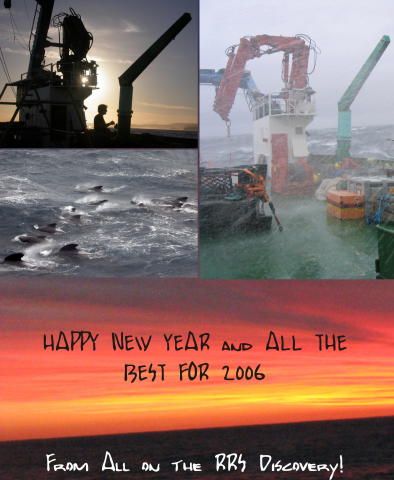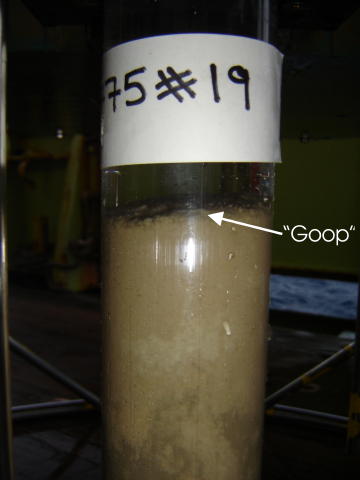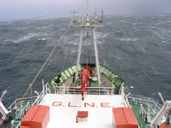| << |
1 |
2 |
3 |
4 |
5 |
6 |
7 |
8 |
9 |
10 |
11 |
12 |
13 |
14 |
15 |
16 |
17 |
18 |
19 |
20 |
21 |
22 |
23 |
24 |
25 |
26 |
27 |
28 |
29 |
30 |
31 |
Crozet Cruising 1/1/2006

HAPPY
NEW YEAR from all on the RRS Discovery!
Time is flying by and it is the New Year already! There have
not been any blogs recently, because we have been hard at
work characterising our Southern, low productivity site! Our
first results clearly show that M6 is very different to M5,
both in terms of the biology and particularly sediment type.

Benthic Crozet study area – a reminder
of the location of the main sites, M5 and M6
The sediment is so soft here that we have been
having real problems collecting the material in our cores.
After one successful megacore, there followed a series of
blanks, which considering that each one takes about 4 hours
becomes very frustrating! However, last night we made a bit
of a breakthrough and have now struck on a more successful
strategy. This involves using less weight and hoping that
the corer doesn’t sink in so far the mud washes over
the top of the tubes!
The notable thing about the sediments is that
often, there is a layer of colourless fluff, or “goop”
on the surface. This may come from a phytoplankton bloom earlier
in the summer; its colourless appearance suggests that it
is not fresh, or that perhaps it is not terribly organic rich.
Until we recover the sediment traps and carry out some detailed
chemistry, we cannot be too certain.
 |
|
 |
| Sediment
core collected at M6. Note the layer of “goop”
(scientific term!) on the surface. The surface is pretty
heterogeneous, as you can see in the photograph of the
surface from above the core (right).
|
Two good trawls have been achieved at Station
M6. As expected the trawls at Station M6 had fewer animals
in the catch and a total weight about one third, on average,
of that collected at Station M5. A few species were similar
between the two sites, but their abundance was very much lower
at Station M6. Holothurians (sea cucumbers) accounted for
90% of the biomass of the trawl samples at Station M5, whereas
they contributed only 70% of the biomass at Station M6. Overall,
the species that were dominant at Station M6 were very different
than those at Station M5. Of particular note was the presence
of a very small holothurian called Kolga at Station M6. Several
hundred specimens, about 1cm long, were picked off the fine
mesh liner of the trawl cod end. However, as the mesh of the
trawl overall is about 4cm it is likely that thousands of
specimens were lost through the trawl mesh while it was on
the seabed. Kolga is notable for the way it suddenly occurs
in mass abundances in the deep sea, perhaps only for a year
or two, often forming dense herds of sea cucumbers of several
thousands wandering over the abyssal plain mud surface. It
is possible that the mass occurrences of Kolga are related
to episodic fluxes of organic matter to the seabed.
Sadly, early this morning disaster struck our
third trawl. The wire parted with 8000 m trailing behind the
ship and the trawl and wire were lost. This now means that
we cannot complete our trawling or our video sledge! Hopefully
we have enough data to be able to do a comparison between
sites, but we will certainly now have to rely on other photographic
systems. WASP, or Wide Angle Surface Photography is one such
technique – more of that in another blog!
 |